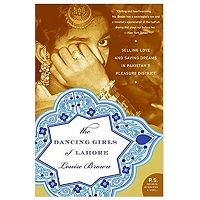The Dancing Girls of Lahore EPUB & PDF – eBook Details Online
- Status: Available for Free Download
- Author: Louise Brown
- Language: English
- Genere: Women’s Biographies
- Format: PDF / EPUB
- Size: 15.6 M
- Pages: 336
- Price: Free
“We Were Artists . . . Not Gandi Kanjri”
( HOT SEASON : APRIL – JUNE 2000)
Lahore is a wonderful city with rich character and a worn charm. The Mughal Empire
has bequeathed some glories to the modern
city: the awe-inspiring Badshahi Masjid;
the imposing Shahi Quila, or Royal Fort;
the pretty Shalamar Gardens; and the now
dilapidated tombs of Emperor Jahangir and
his empress, Nur Jahan. Grand buildings
inherited from the British raj sit in stately,
shabby order on the broad, leafy Mall
Road running through the center of town.
New suburbs have grown—some affluent
and some not. The streets and markets bustle and hum with life and the mosques and
mausoleums are always busy. Best of all,
though, is this ancient place—the Walled
City—a quarter of a million people squeezed
into a square mile of congested tenements
and shops. It is the heart of Lahore and it
carries the city’s soul.
L OUISE B ROWN
Old Lahore can’t have changed much for centuries. The moat
was filled in long ago and the defensive walls have gone, but the residents, constrained by ancient land boundaries and historical memory, continue to build their houses as if the walls still exist: an ageless
and invisible presence. The thirteen gates into the city remain too,
channeling pedestrians and traffic from the wide roads of contemporary Lahore into the narrow lanes and alleys of the Walled City.
Rickshaws, horse-drawn carts called tangas, motorbikes, and small
vans compete with pedestrians for space inside the walls. No vehicles of any kind enter the narrowest alleys. Neither does the sun.
Only in the wider lanes and the bazaars does the sun shine directly
on the ground. Most of the small passages running through the city
lie in perpetual, dusty gloom.
Early morning is the best time to see the old city. During the hot
season there are a couple of hours before the temperature soars and
the lanes become too congested. The city wakes up and life unfolds
in much the same way it must have done hundreds of years ago. The
shopkeepers are busy:
the butchers slice up chickens and goats, the
tea shops open and the bakers prepare halva and fry puri for the first
meal of the day. The fruit and vegetable sellers arrange their produce in a kaleidoscope of bright colors: plump aubergines, mooli, red
carrots, sweet firm tomatoes, bundles of spinach, fresh okra, and
leafy bunches of coriander and mint. Donkey carts rattle and creak
down the galis, the narrow lanes, delivering goods: large round
metal pots carrying milk from the villages; another piled high with
sacks of flour and rice. A rickshaw whose only passengers are a
dozen frantic hens stops and the goods are thrown, squawking, into
the back room of a butcher’s shop.
In the little workshops men and
boys are already at work by seven o’clock, grinding bits of metal,
heating syrupy liquids over open fires, sticking unidentified items
together. It is gray, dirty, repetitive work and it lasts for most of
their waking day
For More Read Download This Book
EPUB



